Text
Trip IV: Adventuring to Bridgeport

An overview map of Bridgeport | Source
Hi everyone and welcome back to the finale of my Chicago neighborhood adventures!
For this week’s blog, I’ll be sharing experiences from my trip to Bridgeport, a residential neighborhood in Chicago. While this entry documents the ending of my Global Chicago class, I hope to still share the excitement this trip brought me in exploring the area’s diverse groups of people, arts, and community identity.
Full disclosure, despite the neighborhood being so close in proximity, this trip was the first time I had been to Bridgeport. Recently I’ve been considering finding an apartment to live off-campus in this area, so you can imagine my excitement to not only uncover the environment and learn the history of the neighborhood itself.

Street panel showing a brief visual history of Bridgeport in relation to other areas of Chicago. Found while walking. | Original photo
Historically, Bridgeport was established in the 1830s by Irish laborers who had originally migrated to help build the Illinois & Michigan Canal. Irish Canal workers settled in what is now known as Bridgeport, and the area later became home to rail workers, slaughterhouse laborers, and many other hard laborers during the beginning of Chicago’s mass industrialization period (WTTW). Following the completion of the canal in 1848, Bridgeport thrived as an industrial center and birthed the popular commercial strip known as Archer Road. This commercial strip thrived in the neighborhood with the later creation of many Catholic parishes, shops, and schools (Encyclopedia of Chicago).
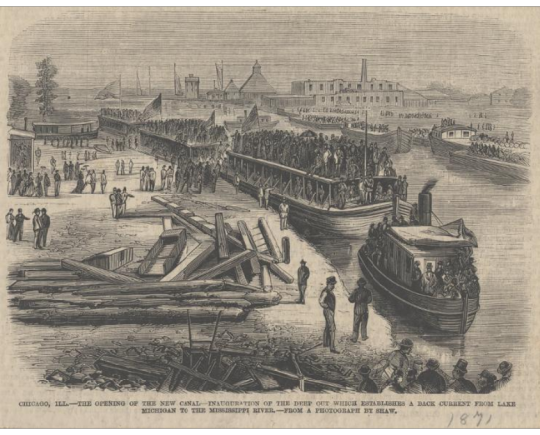
Reopening the Illinois and Michigan Canal in Bridgeport (1871) | Source
In addition to the Irish, Bridgeport soon became home to many Germans, Czechs, Croatians, Poles, Lithuanians, Italians, Hispanic, and Chinese settlers (and many more!) (Lockzero UIC). This migrational pattern can best be observed through Bridgeport’s abundance in diverse churches still present in the neighborhood today. When walking around, there are many European and Asian ethnic group parishes heavily present in the neighborhood, example churches being the Ling Shen Ching Tze Temple (Chinese), St. Mary’s of Perpetual Help Parish & St. Barbara (Polish, as can be seen through the cathedral style architecture), and St. Jerome’s Catholic Church (Croatian).

Inside of St. Mary’s of Perpetual Parish. Note the Polish Cathedral style. | Source
This Polish parish, in particular, caught my eye the most, as I greatly enjoyed seeing the difference in architectural styles based on the ethnic demographics. In regards to the current day community, I believe these churches are a reflection of the neighborhood’s residents and the extensive diverse cultural history of the community itself. In regards to how Bridgeport’s demographics are today, according to Statistical Atlas, 41.4% of the population identified as Asian, 31.9% as White, 21.7% as Hispanic, 3.2% as Black, 1.2% as Mixed, and 0.5% as other.

Race and ethnicity demographics of Bridgeport | Source
Although this was my first time in the area, many of my peers and classmates had informed me of Bridgeport's diversity in residents, and I felt that sharing this demographic would help provide context and understanding for my trip (for my peers were definitely right). Additionally, what was specifically interesting was the small 3.2% Black or African American population in Bridgeport versus the abundance of Black or African Americans in the neighboring area of Bronzeville; were there reasons for this community to gravitate more toward the latter? This was something I wanted to keep in mind for my trip.
Beginning the trip itself, I thought it would be helpful to include the sites I had planned to initially visit when organizing my trip (not limited, just some ideas in mind). The general theme I chose to pursue on this trip was centered around the neighborhood’s art and how it contributes to community identity, especially considering the variety of cultural identities in the area.

Map of my personal itinerary | Original photo
I began my trip by taking the 35 bus heading westbound, riding from 35th St & Federal to 35th St & Halsted. Upon arrival, I decided to walk down Halsted street to get a feel of the neighborhood and most important make observations on the businesses and any signs of cultural diversity (and there was so much of it!)

Diverse businesses in Bridgeport | Original photos
One observation I was quickly able to make was that a lot of the businesses in Bridgeport are very diverse and reflective of the community’s ethnic demographics. A lot of the buildings I encountered were restaurants, a lot of them being of Asian or Latinx descent. Structurally, the buildings are very close together, and some are even right next to housing units with little to no space to spare. This commercial street was almost overwhelming initially to me because of this, as every amount of space seems to be occupied with a business, house, or apartment building. It was also interesting for me to see that the quality/upkeep of a lot of these buildings varied greatly; one side of the street could show restaurants in pristine condition while the other side of the street showed evicted buildings, there was a lot of inconsistency here. Overall, this just made me question the area’s levels of gentrification even more, and if this puts the area at a greater risk of being gentrified or not; some of these buildings seem to be struggling to survive, while others seem to be doing just fine. I was able to observe many people walking around and coming in and out of the establishments, and could tell that community residents valued the businesses. I kept my initial observations and ultimately continued on to explore the rest of the neighborhood.

Jackalope Coffee & Tea House exterior | Original photo
Upon recommendation from my professor, my next spot was Jackalope Coffee & Tea House, located at 755 W 32nd St right off Halsted St. The shop itself was filled with color: the walls had Chicago memorabilia, stickers, flyers, posters, you name it. It was also filled with many young adults chatting, studying, or simply just enjoying the cafe.

Interior/exterior decoration of Jackalope Coffee & Tea House | Original photos
While both in and outside of the establishment, one can notice the abundance of local flyers and events happening in Chicago, many centered around themes of education, art, and millennial culture (concerts, UberEats, cocktail clubs). To me, this appeared reflective of the community residents and caused me to initially question if the neighborhood was leaning more toward a “hipster” one, with the plethora of “hip” style events. With this question in mind, I continued my trip on shortly after ordering a small hot latte (yum)! Overall, I thoroughly enjoyed the cafe, and plan to return sometime with friends or homework.
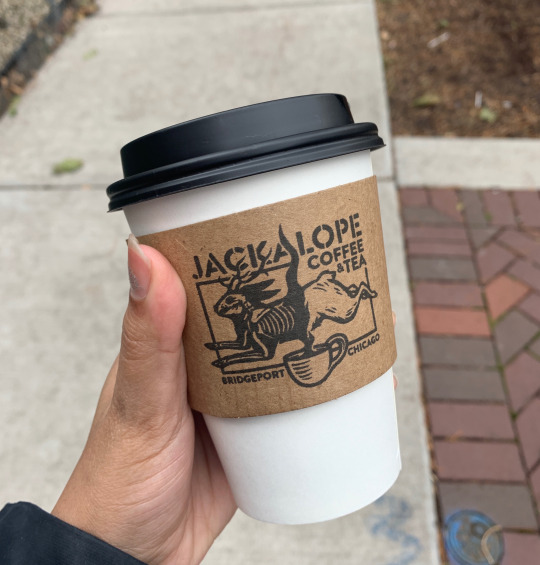
Small hot chai latte from Jackalope Coffee & Tea. Delicious, 10/10 would recommend | Original photo
Next on my list, I planned to visit as many art centers or buildings that I could find, and this venture began with the Chicago Youth Center, located at 844 W 32nd St, a short walk from Jackalope.

The exterior of the Chicago Youth Center | Original photos
The Chicago Youth center was formed in 1956 with a vision of implementing “community inclusion, strong and effective leadership, thoroughly tested programs and continuous innovation” particularly in high-need communities and in partnership with early childhood providers and community schools in neighborhoods (Chicago Youth Centers). This specific Chicago Youth Center is known as the Fellowship house, and the mural is in dedication to the neighborhood's ethnic diversity and those who had migrated to Bridgeport during the building of the canal. The mural itself illustrated images of children and youth, with the repetition of the words “fellow” and “other”. The “other” is referring to someone whose life is unfamiliar to yours, in this case, those who are culturally different, while the “fellow” is referring to someone whose life is familiar to yours, someone who you consider one of your own; both of these words includes stereotypes and associated adjectives painted on the mural as well.

The artist’s explanation of “fellow” versus “other” in reference to the terms included in the art | original photo
This mural was my favorite to see so far on my trip. At first, the concept of “fellow” versus “other” was foreign to me, but the artist does a good job ob explaining the differences between both as your eyes progressively view the mural. The concept is particularly special being in such a diverse neighborhood, as it pays homage to the many “Italian, Croatian, Chinese and Lithuanian immigrants and then Mexican immigrants” that called Bridgeport home by the 1950s (Chicago Youth Centers). Ultimately, as my trip progressed, I was quickly able to deduce that art was a prominent part of the area’s culture and members of the community. This was especially interesting to me considering the variety of ethnic groups that live in the area; art seems to be the uniting factor in bringing cultures and values together in Bridgeport.
This piece of art resonated the most with me after watching Vice’s Streets by VICE: Chicago (Halsted Street), when considering the shift in how ethnic groups previously interacted with each other versus how Bridgeport is demographically structured today. In the video, local Bridgeport business owner Ed Marszewski shares that Bridgeport previously used to be “one of those neighborhoods where if you were a person of color, you would never come here after dark, or you would be chased out”, further illustrating how the bordering expressways of Bridgeport, (Stevenson and Kennedy), were created to “keep the other out” (VICE). Looking at the current racial and ethnic demographics of the neighborhood, it’s fascinating for me to believe that the area has drastically changed from where it’s used to be, especially considering the largest demographic is an ethnic group comprised of POC. This convinces me all the more of how unique Bridgeport truly is as a neighborhood, as I can’t imagine a mural like this, fitting so well in another place in Chicago. The demographic transition makes me hopeful and curious about what the future of the neighborhood holds, and interested to see in how the racial biases change overtime.

Defining racism in the words of the Chicago Youth Center | Original photo
The next stop on my trip was The Research House for Asian Art, however, upon arrival to the location, the building appeared to be closed/unused for the time being. While this was a minor setback, just down the same street I actually stumbled upon the Co-Prosperity Sphere, a cultural center located 3219 S Morgan Street.

Window exhibits displayed at the Co-Prosperity Sphere | Original gif/video
While the cultural center itself was not open to the public during the day of my visit, the art displayed in the windows deeply captivated me as many of the pieces related to today’s political climate in regards to people of color, teachers, the Black Lives Matter movement and children in detainment centers.

A piece titled “Dignidad Rebelde” translating to rebel dignity. The artwork shows many images referring to themes of white supremacy, catholicism, border control, families being split, immigration, and empowering the Latinx community. I found these very profound considering today’s political climate & the negative sentiments/stereotypes about the Latinx community. | Original photo
Regarding one of the exhibits offers this quote from contributing Xicano artists Melanie Cervantes & Jesus Berraza, who believe in “empowering reflection of community struggles, dreams, and visions. These works were created to amplify people’s stories and to create art that can be put back into the hands of the communities who inspire it”.

A look inside of the Zhou Brothers Art Foundation, part of the Zhou B Art Center | Original photo
The next stop on my trip was the Zhou B Art Center located at 1029 W 35th. This was my first time hearing about the Zhou art centers, and I was slightly confused upon arrival, as I couldn’t tell if they were open or closed for the day (because I was on this trip alone, I chose not to enter for safety reasons.)

Statue right outside of the Zhou Brothers Art Foundation. | Original photo
The Zhou Brothers, ShanZuo and DaHuang are globally well renowned contemporary artists, with their extensive 40-year art history of paintings, performances, and sculptures (ZhouBrothers). The Zhou Brothers began their work in the United States after moving here in 1986 and opened the Zhou B Art Center in Bridgeport, Chicago in 2004 with a “dream of providing a platform and creative freedom for international artists” (ZhouBrothers). These values alone made me consider the high population of Asian residents and how this helps them feel represented in the community of Bridgeport, particularly through the art center’s goal of preserving cultural values and providing creative outlets for international individuals.

The exterior of the Zhou B Art Center | Original photo
Overall, when leaving the center, I was left to consider how art can serve as a medium for bringing different cultures together, and for others, it can help connect you to your roots. When considering how this impacts Bridgeport overall, I believe that art centers like this provide opportunity for outside visitors to come and see the neighborhood for all it has to offer. Alternatively, I do acknowledge that an art center like this can potentially make the neighborhood vulnerable to gentrification or developers looking to capitalize off of the area’s cultural richness, as these events would further fuel a potential “hipster movement” in Bridgeport. As for now, Bridgeport’s colorful art scene seems unique and personal to the community, growing and serving as space for community members to showcase their talents, historical roots, and cultures.
To end my trip, I stopped at Stix n’ Brix Wood Fired Pizza for lunch and actually ran into a fellow schoolmate eating at the local establishment (this is my friend Ryan!) While I’m not sure if this restaurant directly lies in Bridgeport, it was right on my walk back to IIT’s campus, located at 220 W 33rd St. The establishment is located right by a neighboring red line train stop and conveniently shares the building with a coffee shop known as the Red Line cafe, where a lot of local students and residents go for studying and mingling. Additionally, this area is home to the notable Guaranteed Rate Field, home to the Chicago White Sox and serving as a popular attraction for tourists all over. The overall ambiance of this area in combination with the quality of the meal made it a location I plan on revisiting in the future.

Lunch break at Stix n’ Brix | Original photo
Pizza rating: 9/10
Overall vibe: 10/10
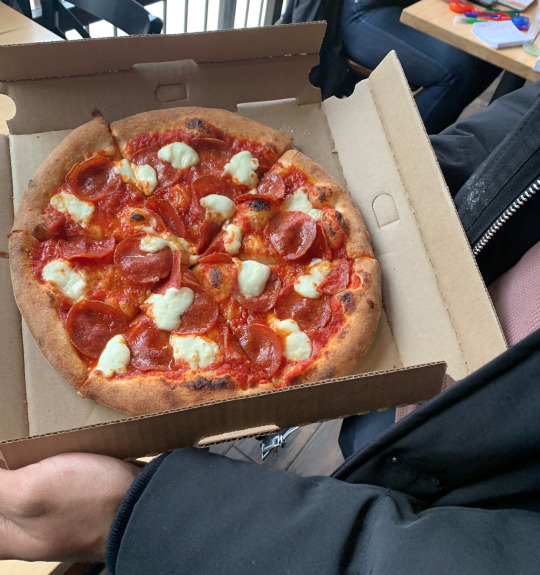
An up-close pizza shot. Delicious. | Original photo
As I ended my trip, the neighborhood itself left me to question what the future holds for the area and if it’s at risk for gentrification. What compels me to believe the area may someday turn into the next “hipster” neighborhood is that a very prominent part of the area’s culture is centered around the arts, much similar to what I was able to observe when venturing to Pilsen.

Mural located outside of the Co-Prosperity Sphere art and cultural center. Very reminiscent of the murals previously seen in Pilsen: colorful in art and in cultures represented. | Original photo
A lot of parallels can be drawn to the area when comparing them: rich in diversity, culture, and art through mediums of murals, commercial businesses, and tourist attractions. While these elements, particularly the arts, can serve as strong opportunities for communities, they run a financial risk of attracting investors and businesses capitalizing off of the neighborhood’s cultural and artistic richness. This is best understood through Aimee Levitt’s illustration of the hipster in her work, The Migration of the Hipster, asserting that hipsters are “colonizing and commercializing everything that made the neighborhood so great, transforming it from bohemia to brohemia”. I’m deeply conflicted about this question, purely because Bridgeport’s history shows me that the neighborhood is built on the efforts of the working class, and I can imagine that residents of the neighborhood care for their community’s roots and maintaining its value. While it someday maybe the next new “hipster” neighborhood, I feel that the neighborhood’s current-day wide range in diversity helps with cultural preservation and combats gentrification. I’m hopeful (yet cautious) that Bridgeport will continue to blossom into the complex and diverse neighborhood that it is.

Mural located outside of the Chicago Youth Center. My favorite part of the art: “Remember. Life is Precious” in regards to judging others. | Original photo
Ultimately, I thoroughly enjoyed my final neighborhood trip and was glad that I was able to spend it in Bridgeport, and know it will not be my last. For my next trip, I’d love to focus more on the religious themes of the neighborhood, but this will have to wait for a warmer climate. Learning about this historical and cultural gem only further excites for what the city of Chicago has to offer, and I highly recommend you visit the area yourself.
Global Chicago, thank you.
References:
https://statisticalatlas.com/neighborhood/Illinois/Chicago/Bridgeport/Race-and-Ethnicity#figure/relative-race-and-ethnicity
https://interactive.wttw.com/southside/near-southwest/bridgeport
https://www.chicagoyouthcenters.org/history
http://www.zhoubrothers.com/about.html
https://lockzero.org.uic.edu/I.html
https://openhousechicago.org/sites/site/st-mary-of-perpetual-help-roman-catholic-church/
https://www.youtube.com/watch?v=P8WwazfHlhY#action=share
2 notes
·
View notes
Text
Trip III: Exploring Pilsen
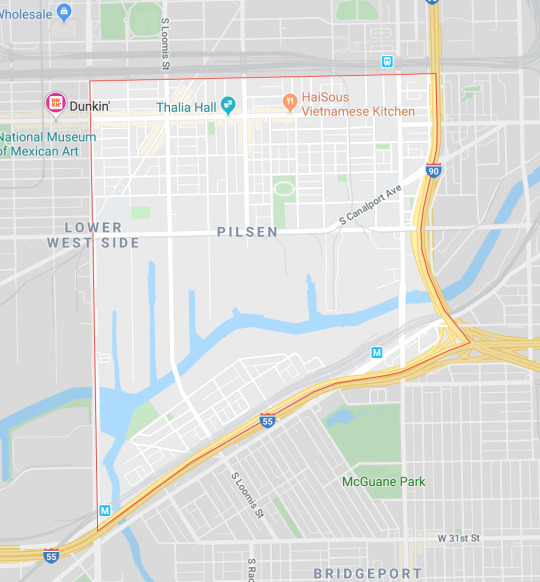
Hello everyone and welcome back!
For this week’s adventure, a small group of my classmates and I ventured to the very colorful and culturally rich neighborhood of Pilsen. Similarly to what happened on my last trip, this was unfortunately adventure was a rainy one, but nevertheless the excitement of the art and Latinx culture was enough to get me out of the house (and there thanks to Uber. whoo!) As someone who grew up in Aurora, IL, in a primarily Latinx community, I was deeply excited for this trip. This trip my first to the area, and I was specifically enthused by the neighborhood's artwork/outdoor murals, cultural foods, language differences, and decorations for the upcoming dia de Los Muertos (Day of the Dead), a traditional Mexican holiday dedicated to memorializing the dead. If you’re unfamiliar with Pilsen, allow me to provide some quick insight into the neighborhood itself.

A banner depicting the saying “Brown is beautiful, Beloved Asheville”. The term Brown refers to the Latinx community in Pilsen, as the banner serves to empower its members. This message helps combat negative stereotypes and unite the Latinx community from all walks of life, as evident in the varying caricatures. | Original photo
Statistically speaking, according to the Statistical Atlas, the neighborhood of Pilsen is predominantly Hispanic, as they make up 70.7% of the population. While observing the area this stat was proven true from the abundance in Latinx businesses, restaurants, and other amenities. While this statistic accounts for a majority of the population today, Pilsen’s neighborhoods had not always been this way. It was not until the 1960s that Pilsen transformed into what we know as the primarily Latinx neighborhood that we see today. Prior to this time period, the area was mainly populated by “Central and Eastern European descendants - including the Bohemians” and referred to as Plzeň, named after a city in today’s Czech Republic (Mitchell, 2014). According to the same source, the neighborhood shift in demographics can be best explained by Chicago’s massive city projects during the 1950s, including expressways, public housing developments, and a university campus (the University of Illinois in Chicago, interestingly enough!); these editions ultimately caused the ethic shift, as Mexican residents to move from the Near West Side into what is now Pilsen.
I decided to begin my trip venturing down W. 18th Street, starting around the corner of West 18th Street and South Carpenter Street. As I began walking, I took note that the area was characterized by an abundance of community resources including restaurants, salons, independent shops, insurance businesses, churches, and even laundromats. The area was a mix of both family-owned businesses, franchises, and independently-owned stores unique to Pilsen.

A street vendor’s fruit stand, full of variety. | Original photo
As I began exploring the area, the first thing that instantly caught my eye was surprisingly a Vietnamese Cafe/Restaurant, titled HaiSous Vietnamese Kitchen located on the corner of W 18th St and S Carpenter Street. On one hand, as a person who identifies as half Vietnamese, I was very excited to see this place (as Vietnamese cuisine is only usually available in the Chinatown area) but on the other hand, I was genuinely surprised to see this in the area. After reading Pilsen’s neighborhood history, I was anticipating seeing mostly Latinx and European-themed businesses, so this was a pleasant surprise to begin my trip on, and later ended up foreshadowing the neighborhood’s abundant cultural diversity.

Vietnamese cafe and restaurant, ‘HaiSous’ located on the corner W 18th Street and S Carpenter Street. | Original photo
While I was at the establishment, I ordered a small Lychee danish for breakfast. Lychee was one of my favorite snacks growing up and is a traditional fruit in my family. Overall the pastry was a 5 out of 5 stars, filled with nostalgia and the delicious lychee cream cheese spread; I definitely recommend it if you’re on the hunt for a small bite!

Lychee danish. | Original Photo
As I continued my walk, the first church-related site I encountered was a shrine located on West 18th Street and South Allport Street, right next to the St. Procopius Catholic Church. Upon first glance, I was ecstatic to see this site, as the area was surrounded by foliage and colorful flowers, with the shrine in the center. (The area was extremely calming and well maintained. Beautiful.) While I wasn’t able to enter and explore the church itself, I took some time to learn more about the shrine itself and the significance to the area.

Shrine of the Virgin of San Juan de Los Lagos | Original photo
For Pilsen community members, the shrine serves as a site for completing promises or mandas (vows in traditional Mexican Catholicism) at one’s own pleasure. The woman depicted in the center of the shrine is known as Our Lady of Guadalupe (also the Virgin of Guadalupe) and is notably a powerful symbol of the Mexican identity and faith, commonly associated with attributes such as empowerment, motherhood, or resilience (Reyes, 2016). The figure is highly embedded into Mexican culture, particularly through religious influence, as best seen depicted on the site’s shrine. Catholicism itself has a large influence on Latinx culture, as I was able to best observe it through the many art murals in the neighborhood. Many of the murals I encountered were either in dedication or featured some form of the powerful symbol; for me, this showed the community’s importance in not only religious values but values that Our Lady of Guadalupe herself represents.
With that in mind, the next few photos are some of my favorite art pieces I encountered while venturing through Pilsen. The community’s abundance in art and murals makes it comparable to a museum. Of all the trips I have taken so far, this trip was the first where I had experienced public art at this frequency; it is apparent that the neighborhood values its murals and the messages that they provide, topics including religion, love, history, or injustice. No other community I have seen so far does public art like Pilsen, making it my most vibrant trip so far.
Without further ado, here are some of my favorites:

Art mural of Our Lady of Guadelupe. The angelic figure at her feet displays red, white, and green, resembling colors of the Mexican flag, as the angel’s wings resemble those of the eagle in the flag’s center. These elements help portray the mural’s theme of freedom and pursuing the American Dream. | Original photo

Additional dedication to the Virgin of Guadelupe | Original photo
This depiction of the religious figure was particularly interesting to me. This piece of art was located on the exterior of a children’s youth center/school building and portrays the Virgin of Guadelupe with younger features mirroring the youth.

Hidden mural. This piece of art touched me emotionally, as I felt it best represented the American Dream for those migrating to the United States. | Original photo

Art depicting cards of the Mexican card game, “La Loteria” | Original photo
While further exploring the public art and murals on W 18th Street, one thing that struck my interest was the addition of art referencing a popular Mexican card game, coined by the name Loteria. The vibrant and colorful pieces were spread throughout the street, hidden on doors and wall corners, paying homage to traditional Mexican culture.
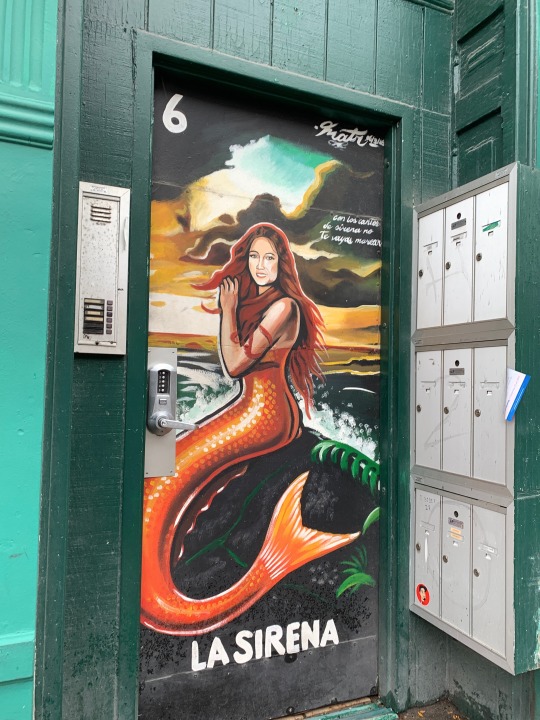
La Sirena Loteria Card. The text in the upper right-hand corner reads “Con los cantos de sirena, no te vayas a marear” translating to “Don't get dizzy with the songs of the mermaid.” | Original photo
La Loteria is a traditional Mexican card game, typically played in family settings and holiday celebrations, and is often compared to being a “Mexican Bingo”. The visual depictions on the cards are imperative to playing the game; while an American Bingo announcer calls out sequences of letters and numbers, i.e., “B-4”, Loteria operates off the premise that an announcer describing general ideas or poems related to the images on the card, i.e., “the coat for the poor” referring to the Sun card (Villegas, 2019). The card game traditionally offers a select set of images and Pilsen’s interpretation of this can be seen in their customized depictions of the cards, unique to the community and the neighborhood. Seeing this was a small but mighty addition to the neighborhood art, ultimately reminding me of playing La Loteria in my hometown with family friends. Small additions like this show the neighborhood artists’ attention to detail when preserving culture; as Loteria is a game that has surpassed many generations and emulates values of family and unity.
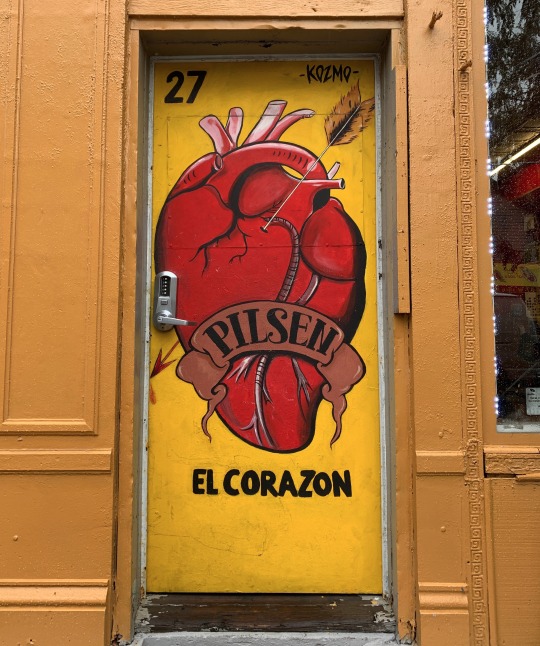
A traditional card in the game La Loteria, “El Corazon”, customized to pay homage to the neighborhood of Pilsen | Original photo
To conclude my trip to Pilsen, I stumbled upon the Pilsen Vintage & Thrift, located at 1430 W 18th Street. This shop was just as vibrant as the rest of the neighborhood, filled with vintage goods either sourced or inspired by Latinx culture. To commemorate my trip, I even purchased a couple of small souvenirs including a ring, earrings, and stickers as a way of supporting the community and thanking the shop owners for allowing in-store photography.

The initial view of Pilsen Vintage & Thrift when walking in | Original photo

Pilsen Vintage & Thrift store interior | Original photo
Before leaving the shop, I actually sparked up a conversation with the store’s cashier, asking her about her experience working in Pilsen and her general thoughts about the area. She shared many stories of her early life growing up in Pilsen, but when discussing the state of the current day area she concluded gentrification was definitely happening, as she shared “my rent has almost doubled in the last year with all the newer businesses taking over previously family-owned ones” (she requested not to be named for the sake of this post). From my observations following my trip, I could see that neighborhood is known for being a cultural hub, both in its historical roots and today as well. With the neighborhood’s high frequency in the arts and culture, this opens up a large fiscal opportunity for businesses to capitalize on the neighborhood driving out native residents and family businesses replacing them with ones accommodating more toward middle-class customers and residents. This can best be understood through the context of Pilsen’s perceivably profitable identity, one that “market initiatives [are] now employed to ‘renew’ such neighborhoods [as] Pilsen itself can be packaged and sold as a site of culture” (Saclarides, 2009). Off first glance, the area just seems to be “balanced” in terms of offering both family-owned, culturally significant business and “affluent” style businesses or popular corporations, but when observing this through the lens of gentrification, I can’t help but wonder how native residents feel about the changes in the community. Ultimately, while some may view this act of cultural commodification as a “beautification” of the city neighborhood, these driving forces of increasing consumerism and tourism tend to leave residents of ethnic neighborhoods feeling intruded on or out of place; as consumption and commerce don’t tend to follow with compassion and cultural preservation (Saclarides, 2009). Pilsen has come far from what once was viewed as an “overcrowded, decaying site of contagious social pathology, often [once] tagged as ‘ghettos’, ‘slums’ or ‘barrios’”, and continuing this development of the neighborhood needs to include the resident’s cultural values while still pushing for advancement (Saclarides, 2009).

Flyer advertising a protest, advocating for children in border detention centers. Found at the register/check out area of Pilsen Village & Thrift. | Original photo
Ultimately, I thoroughly enjoyed my trip to Pilsen, and hope to return to the area soon. While my one regret on this trip was not stopping for lunch, I still felt immersed in the culturally rich neighborhood, leaving with a new perspective on one of the many communities Chicago offers. I enjoyed reminiscing on aspects similar to my own hometown and particularly took great interest in the vibrant street art. With all this being said, for any of you even considering visiting the neighborhood: 100% go for it! Pilsen offered me a new perspective on cultural expression and community and left me ready to plan for my next trip back (and start practicing my Spanish again!).
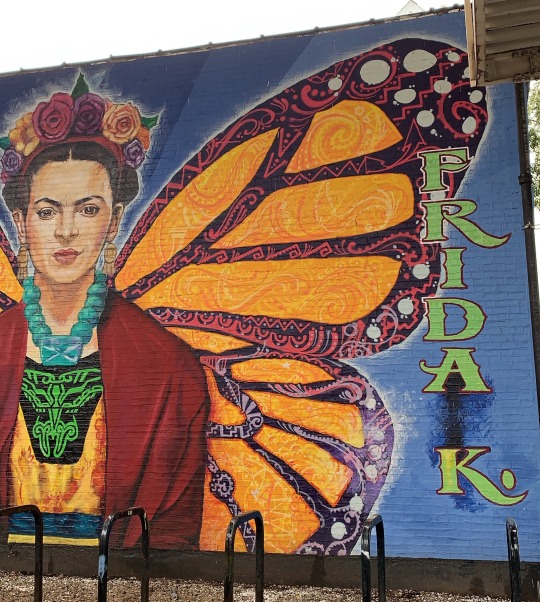
Mural of Mexican painter Frida Kahlo, an important figure in Latinx culture. One of my favorite artists and favorite murals I saw. | Original photo
Sources:
La Sirena. Mexican Figuritas. Loteria postcard. The Mermaid. (n.d.). Retrieved from https://www.changingworld.com/la-sirena-mexican-figuritas-loteria-postcard-the-mermaid.html.html.
Mitchell, C. (2019, May 1). The birth of a Latino community. Retrieved from https://www.wbez.org/shows/wbez-news/swept-from-their-homes-chicagos-latinos-built-new-community/331fcc5d-be0b-4b20-be9f-245a562a9310.
Race and Ethnicity in Pilsen, Chicago, Illinois (Neighborhood). (n.d.). Retrieved October 17, 2019, from https://statisticalatlas.com/neighborhood/Illinois/Chicago/Pilsen/Race-and-Ethnicity.
Reyes, R. A. (2016, December 12). Our Lady of Guadalupe Is a Powerful Symbol of Mexican Identity. Retrieved from https://www.nbcnews.com/news/latino/our-lady-guadalupe-powerful-symbol-mexican-identity-n694216.
Saclarides, K. (2009). Selling Chicago as a Global City: Redevelopment and Ethnic Neighborhoods. On University of Chicago - SSA: Advocates' Forum.
Villegas, T. (n.d.). History of La Loteria. Retrieved October 17, 2019, from https://teresavillegas.com/history-of-la-loteria/.
0 notes
Text
Trip II: My Trip to Bronzeville!
For the purpose of consistency, this post has been broken up into two parts: my first and second trip to Bronzeville; experiences from two separate days.

Neighborhood map of Bronzeville, Chicago | Source
Hello everyone! I’m back with a new addition to my travels around the City of Chicago, with a very exciting entry for today!
This past Friday, September 27th my classmate Alexis and I ventured to the historic neighborhood of Bronzeville! This trip has been my favorite thus far, as exploring the area offered themes of rich history, art, culture, and constant surprise. If you’re unfamiliar with the neighborhood, Bronzeville, also known as the “Black Metropolis” of Chicago, was considered the heart of the African-American community following the Great Migration in 1916 and is recognized for its historical significance, lively community, rich culture, and musical legacies, specifically in genres of jazz, blues, and gospel (Bean, 2016). As someone enthused particularly by African-American arts and specifically jazz history, you can imagine that I was ecstatic to take this adventure. Truthfully, I could go on and on about all the reasons I was excited to get to know this neighborhood, but let’s dive in to see for yourself.
PART I: exploring Bronzeville; rain or shine!
On the first day of my trip, I went in partnership with my classmate Alexis, who I later discovered is a born and raised Chicagoan. In contrast to my last trip, accompanying someone with insight from growing up in the city was helpful in navigating and noticing changes throughout the neighborhood.
Our first stop on our itinerary was mural located on the side of the “L” station 35th and State St. As to my knowledge and observations, the mural that was previously on the side of the 35th-Bronzeville-IIT station had been recently covered up, and is now just a painted wall. The original mural showcased the neighborhood’s name Bronzeville across the top and featured caricatures of artists in the likes of Mahalia Jackson (the “Queen of Gospel”), Etta Moten Barnett (actress/vocalist), Nat King Cole (jazz pianist/vocalist), Dinah Washington (pianist/vocalist), R. Kelly (singer/songwriter), Chante Savage (R&B/dance singer), and Duke Ellington (jazz orchestra leader/pianist), all notable artists who contributed to the Black Metropolis’ rich musical legacy and the nuance of the community (Biography.com, 2019). Side thought: while the previous mural did pay rightful homage, my thoughts on why it was covered potentially revolves around the recent scandal with artist R.Kelly and the neighborhood not wanting to be reflected through the uproar. Seems justified but sad to see the others go.)
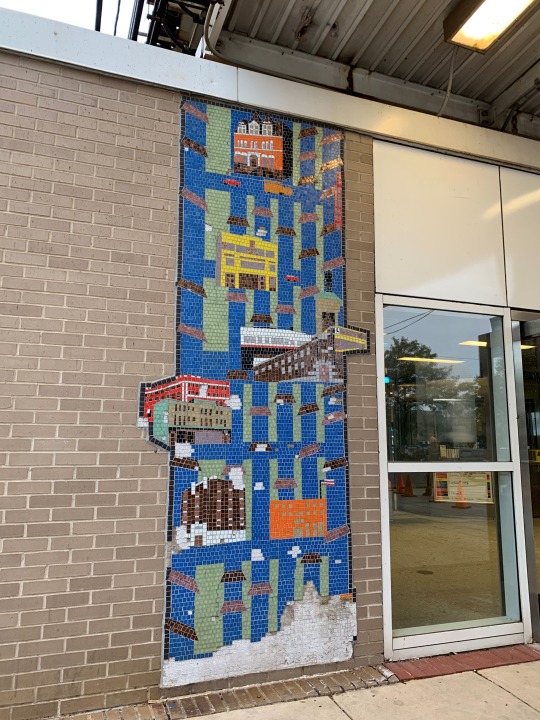
35th-Bronzeville-IIT South entrance mural | Original photo
While we didn’t get a chance to see the previous mural, we did however get a chance to view this mural placed right by the entryway of the “L” station, depicting 6 landmark buildings in colorful tile, accompanied by a neighboring sign with the “Bronzeville Points of Interest” (two being my university!) While I couldn’t find any historical information on this, I believe the buildings feature Bronzeville’s historical landmarks of the neighborhood, potentially including the Wabash Avenue YMCA, the Chicago Defender Building, Unity Hall, Eighth Regiment Armory, and the Sunset Cafe/Grand Terrace Cafe (City of Chicago, 1984). Overall, I thought the vibrant miniature mural was a nice addition to the CTA stop and gives new/returning visitors a look into how the neighborhood values its history. The points of interest plaque made me feel like I was visiting a museum, despite living in the area this entire time; ultimately, it was refreshing.

Bronzeville points of interest plaque | Original photo
Next on our trip, we spotted Welcome Stele, additionally located on 35th and State St. The monument offers 3 differing sides, all displaying texts containing the Bronzeville’s historic leaders and figures within the neighborhood; including lawyers, businessmen, and officials.

The first side view of the Welcome Stele | Original photo
This first side of the Welcome Stele focuses on the general theme of African Americans' business endeavors, most evidently highlighting the versatility and range in careers responsible for the commercial growth of Bronzeville. The latter half of the Stele displays where the neighborhood coined its name, as “Bronzeville” comes from the development of the bronze-beauty pageant by James Gentry who was a Chicago Bee and Defender.

The second side view of the Welcome Stele, depicting Bronzeville’s community figures and political milestones | Original photo

The third side view of the Welcome Stele, illustrating State St. once being the commercial hub of Bronzeville | Original photo

Bronzeville Walk of Fame plaques | Original photos
The next goal on our list was to successfully complete the Bronzeville Walk of Fame, from beginning to end, located on King Dr. between 25th and 35th Streets. The neighborhood’s walk of fame contains “ninety-one bronze plaques on medians, sidewalks, and crosswalks stretch ten blocks” honoring those who have made noteworthy contributions to the African American community from all walks of life and careers (enjoyillinois.com).
As we began the walk of fame, we noticed the plaques showcased an incredible variety of notable Chicago figures, ranging from doctors to musicians to poets to architects to lawyers and boxers. The significance of the walk of fame truly resonated with me when I saw the number of plaques placed outside of the Paul Laurence Dunbar Vocational High School; the walk of fame serves to not only memorialize and commemorate Chicago figures but motivate future generations for success. While walking down the sidewalk, I additionally noticed the area’s value in the youth and younger generations through the plaques, advertisements for youth activities, and even positive messages on public benches. Bronzeville’s preservation of art, culture, and community promote positive messages to the youth, which I found touching considering the amount of stigma and stereotype around Chicago public schools.

“Youth r thought” engraving on public bench, located in school zone | Original photo
At this point in our trip, while I would like to note that it had started to rain (I apologize for rainy photos!) it didn’t stop us from making our next stop to observe the Bronze Map of Bronzeville after finishing the walk of fame.
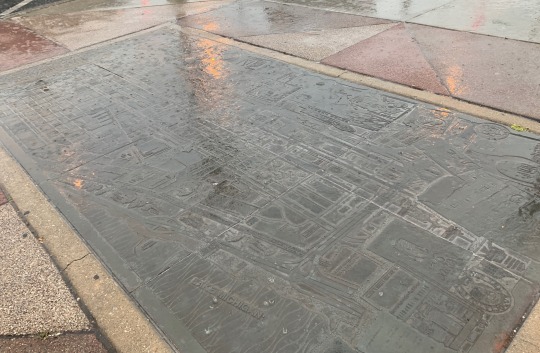
Upper righthand corner view of Bronze Map of Bronzeville | Original photo
The Bronze Map of Bronzeville best displays the neighborhood's rich culture and history through the institutions included on the map, some examples being the Quinn Chapel, Chicago Defender, Chess Records Studio, and the Illinois Central Railroad Station just to name a few. Ultimately, the map illustrates what Bronzeville used to be as a neighborhood; one filled with variety in opportunity, businesses, commerce, institutions, and community makeup. This overall theme can still be seen throughout the neighborhood today but with small changes and additions, but the map serves a reminder of the area’s roots and booming beginnings.
~ LUNCH BONUS! ~
At this point in our trip, the weather had gone from a slight drizzle in rain to a full downpour, indicating it was a good time to end our trip and stop for lunch. In an attempt to escape this bad weather, Alexis and I decided to dine at Harold’s Chicken Shack, (124 E 35th St.) as we both frequented the establishment often and avidly enjoy their food (one of my favorite late-night meals!)

Lunch at Harold’s Chicken Shack | Original photo
Just as always, my lunch at Harold’s was delicious! I ordered the wing lunch combo which came with 4 wings, fries, bread, coleslaw, and a drink of choice, all for $6.50 (wow! incredible deal for a college student.) As someone who had only dined at Harold’s during the nighttime, I thoroughly enjoyed the lunch deal and felt that it was extremely filling and worth the price! (Other customers must have also shared this thought: during our visit, many workers from around the area were coming in and getting the deal for their lunch breaks, indicating the deal’s popularity).
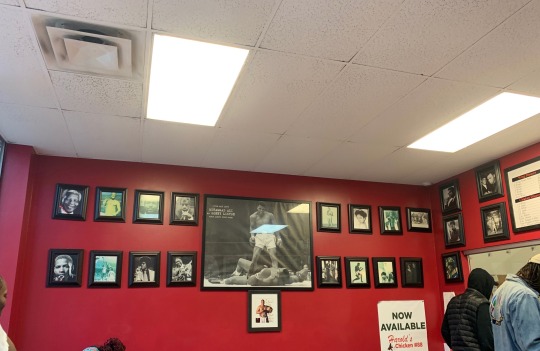
Harold’s Chicken Shack interior decoration. Something I always enjoy about the establishment: preservation of culture. | Original photo
Overall lunch rating = 5/5
Notes: incredibly filling, delicious hot sauce, the chicken was crispy, the staff was efficient and the overall environment was nice especially with the historical photos along the walls!
If you’re looking for a quick but delicious meal, I definitely recommend the lunch combo. Ultimately, this meal was an extremely fulfilling way to end my first day of adventures in Bronzeville.
PART II: Boulevards & Sunshine!
While my first trip to Bronzeville had to be cut short due to poor weather conditions, I decided I’d take another day to further explore the neighborhood. On this second day, the weather was nice and warm, creating a perfect climate for me to venture to a few more sites!
My first stop on this day was the Victory Monument, located between 35th street and King Drive. The bronze sculptor itself was constructed with the intent of honoring “the achievements of the Eighth Regiment of the Illinois National Guard, an African American unit that served in France during World War I...”, additionally showcasing a soldier on top of the fixture signifying all the Black soldiers who had died during the war (Chicago Outdoor Sculptures, 2009).

Right-facing view of the Victory Monument | Original photo
Seeing this monument in person gives you chills as a spectator, whether you’re aware of the historical significance yet or not. At least this is how I felt seeing the monument for the first time. The posture and position of the soldier at the top radiates power and stoicism, accompanied by the additional figures below. While my favorite part of this trip will soon be discussed (hint, hint), I have to note that this part of the trip affected the most emotionally. While the reason for its creation can be saddening, I am glad the neighborhood prioritizes paying homage to its fallen soldiers and past generations.
As I continued my walk down the street, my next stop was the Ida B. Wells-Barnett House, probably my most exciting stop thus far, as I admittedly didn’t know this historic landmark was located so close to me.

Front view of Ida B. Wells-Barnett House | Original photo
Ida B. Wells was an African American journalist, suffragist, and Civil Rights activist who was known for leading an anti-lynching campaign in the United States during the 1890s (National Park Service, 2019). As a journalist, Wells wrote and recorded the gruesome reality of African Americans being lynched and began her anti-lynching campaign.
Standing in front of her home really allowed her historical legacy to resonate with me, as this part of the trip was humanizing to the work she had done for not only the community but for African Americans as a whole. Detail wise I enjoyed the architectural style of the nearby homes and particularly enjoyed the maroon accents and stone/brick style exterior. Ultimately, this part of my visit was what made me most proud to reside in a neighborhood like Bronzeville.
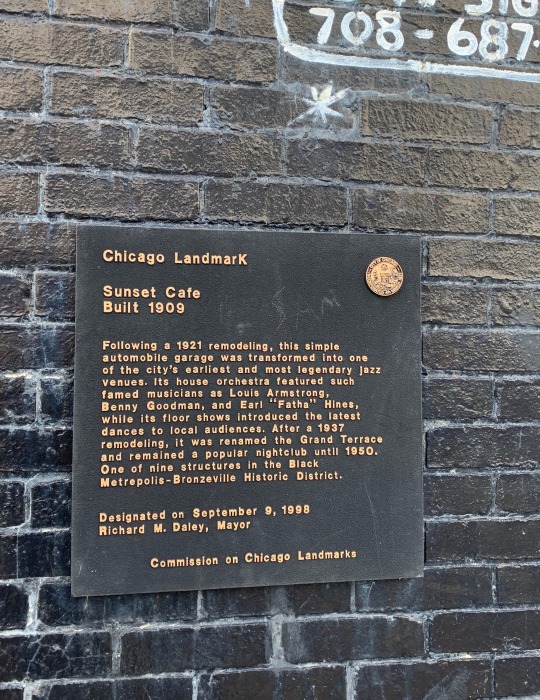
Finally, this last stop on my trip took me by surprise. On my commute back home, I stumbled upon the building that once housed the Sunset Cafe/Grand Terrace Cafe, a once-popular “nightclub that established Chicago’s reputation as a jazz center in the 1920s and 30s” and is now a current day beauty supply store titled “Urban Beautique” (City of Chicago, 1984). Jazz clubs and jazz music as a whole was a large contributor in shaping the culture and entertainment of Bronzeville, with notable artists like Louis Armstrong featured in clubs like these during the early 20th century. After reading the plaque and keeping these thoughts in mind, I was in awe after stumbling upon this landmark.

Mural inside of Urban Beautique from the original jazz club | Source
Alternatively, on the exterior of the building, next to the Cafe’s historic plaque is a mural dedicated to the beauty store, filled with vibrant colors and a painting of an African-American woman with a hopeful expression. While some may question if visitors of the beauty store still hold value in the building that once was, I believe that the building’s change from popular jazz club to beauty shop is reflective of how communities interests and means of fulfillment change; beauty supply stores are increasingly popular in African-American communities, as they are not only hubs for supplies but great places to exchange hair/beauty advice and build connections while shopping. Although it is no longer the historic jazz club it once was, the building’s liveliness is still present within the store, just shifting to current-day community interests.

Mural outside of Urban Beautique, site of the original jazz club | Original photo
Ultimately, both trips I made to the neighborhood of Bronzeville were equally as fulfilling and eyeopening to a culturally rich community I had yet to take the time to explore. Prior to this trip, I have to be honest and admit I wasn’t aware of the historic milestones a neighborhood this close to me had experienced, but now I am nothing but thankful for this treasure I can return to. The music, the art, the culture, the sense of community, and the legacy all provide me with a sense of pride to be an African-American woman and assure me that future generations coming out of Bronzeville will share that same sense of pride and hopefully continue the neighborhood’s success.
Sources:
(n.d.). Retrieved from https://www.google.com/maps/place/Bronzeville, Chicago, IL/@41.8201572,-87.6351753,14z/data=!3m1!4b1!4m5!3m4!1s0x880e2bf824a02f89:0xcefdff19c5833998!8m2!3d41.8166444!4d-87.6167744.
Bean, A. (2019, June 12). The Incredible History and Cultural Legacy of the Bronzeville Neighborhood. Retrieved from https://www.chicagodetours.com/bronzeville-neighborhood/.
Bronzeville - Victory Monument. (2009, September 28). Retrieved from http://chicago-outdoor-sculptures.blogspot.com/2009/09/victory-monument.html.
Bronzeville Walk of Fame. (n.d.). Retrieved from https://www.enjoyillinois.com/explore/listing/bronzeville-walk-of-fame.
Mahalia Jackson. (2019, July 11). Retrieved from https://www.biography.com/musician/mahalia-jackson.
Wbez. (2018, May 24). What's That Building? The Sunset Cafe Mural. Retrieved from https://www.wbez.org/shows/morning-shift/whats-that-building-the-sunset-cafe-mural/ad11a2c2-b786-4477-be32-7f93caf5439f.
0 notes
Text
Trip I: Exploring Chinatown!
This past Friday, September 6th, a group of friends and I from my Global Chicago class had the opportunity to venture to Chicago’s Chinatown! While I had been a regular visitor to the area’s popular restaurants and bakeries, my previous experiences in Chinatown were extremely limited; this gave me all the more reason to look forward to exploring the area’s rich cultural history, architecture, and overall lively community. For this trip, our group of 3 constructed a small itinerary, keeping in mind to explore Chinatown’s rich history, as it is notably among Chicago’s most culturally authentic neighborhoods, and differs significantly to other Chinatowns; Chicago’s continues to grow as its community continues to preserve cultural values and traditions (Ecker, 2019). With these thoughts in mind, we set off.

Welcome to Chinatown Map. This is the map that is shown in various areas of Chinatown, this one specifically found close to the nearby Redline exit, readily available for new or returning visitors. Most notably, the sign appears in both English and Traditional Chinese. This foreshadows a common theme observed later in the trip. | Original photo
As my group members and I began our adventure to Chinatown, we decided to take the LaSalle and 33rd street bus, as we noticed the bus route took us directly through 2200-2500 S Wentworth Avenue, leading us right to Chinatown’s many shops and businesses. We exited the bus right in front of the Chinatown gate, and what instantly caught my attention was the abundance of people, walking, conversing, getting into vehicles, or selling goods, occupying the streets. To be completely honest, I had only been to Chinatown a handful of times, most of them being late-night food runs with friends, but this experience was very different! Going to Chinatown at night, most of the people I typically saw had been tourists, doing the same as me; simply there for food or something quick. Contrasted to what I was seeing then, Chinatown during the day was illuminated by the areas shopkeepers, workers, and everyday people living in the area. (As you can see in some of these photos, I was trying really hard not to accidentally photograph anyone, people were everywhere!)
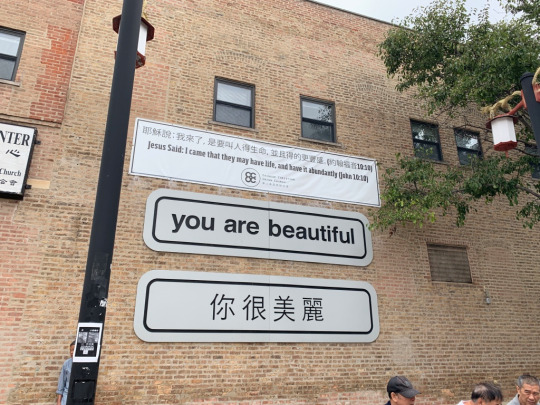
You are beautiful sign. This was the first thing that stuck out to me as I exited the bus. A very pleasant welcoming, accompanied by the area's abundance in people, as seen in the bottom corner of the photo. | Original photo
Making our way further down the commercial street, I noticed the wide range in products being sold by various vendors, with overall themes of gift shops, cosmetic stores, beauty salons, restaurants, markets, houseware stores, the list seemed to go on and on. From medications to souvenirs, the street was filled with fast paces customers and what appeared to be lots of family-owned/independent businesses. The shops are well acquainted with their clientele, as I noticed many advertisements and signage were both in native languages, specifically Traditional Chinese, and English as well. Although my group and I didn’t get the chance to step foot into these shops, we still felt well accommodated and welcomed; generally, I was filled with excitement and lots of curiosity walking down this street.

Herb shop among many others on the commercial street. While in-store photography was prohibited, the outside storefront was the closest I could get to photographing the ginseng. Notably interesting way of storing/selling the herbs. | Original photo
Specifically, one thing I was eager to see being sold in these shops was ginseng, after my professor had mentioned the product’s popularity and abundance in the area. Ginseng is very popularly sold in Chinatown and is known for its ability to act as “an adaptogen, balancing bodily functions” (Chinatownreport, 2018). To my surprise, however, every ginseng carrying shop we attempted to explore had large signs showing that store photography was strictly prohibited. It made us question the overall reasoning behind this; is ginseng really that popular of a commodity? Is it rare? I may never know, but respect the potential of cultural significance being the reason behind its mild secrecy.

Herbs in storage up close. The size and presentation were very interesting to me; I had never seen herbs like this before in my hometown. | Original photo
Before exiting commercial street, the Pui Tak Center was the next stop on our list. Off first glance, I was able to note the building greatly contrasted with the street’s abundance in shops. Although I wasn’t able to enter the building out of the sake of time, allow me to paint you a picture (before showing you actual photos) in an attempt for you to understand the state of awe I was in upon first glance. Exterior wise, the building was significantly taller than its neighboring shops, characterized by all-brick walls and detailing colors of red, teal, navy blue, and tan. Standing outside of the building, I noticed the architecture was unique, including traditional roofing and accents, and many pillars. Being surrounded by sounds and sights of busy customers, workers, and general people, the Pui Tak center serves as a “church-based community center” that provides the Chicago Chinatown and surrounding communities with programs concerning adult education, youths/children, music, technology, and immigration services (puitak.org).

The Pui Tak Center, front-facing/left corner view. | Original photo
The next landmark our group went to view was the Nine Dragon Wall. This wall is the first piece of art seen by visitors when exiting the red line station, and most evidently the first large piece of art we saw after passing through the commercial street of Wentworth Avenue. The wall itself was modeled after the original Nine Dragon Wall constructed in 18th century Beijing, and is actually one of the only three existing replicas made outside of China (chicagochinatown.org). The Chicago Nine Dragon Wall is characterized by 9 dragons in the center, including the colors red, gold, and blue; in traditional Chinese culture, dragons are chosen to represent a mascot of powerful status, while the 3 colors are chosen to represent focus and good fortune. Symbolically, the number 9 is chosen to signify yang, as Ancient Chinese texts “categorized numbers into yang numbers and yin numbers”, yin and yang serving as a symbol for balance and 9 being the highest and largest yang (Oakes, 2017). Seeing the wall up close was comparable to viewing a work of art in a museum. The vibrancy of the colors and the details in the dragons is refreshing to see anytime I take the Redline to Chinatown, I can’t help but marvel in its beauty; I haven’t seen anything similar to it before. Learning the history behind the wall makes me want to visit it once more, now knowing that every component is symbolic to the areas of cultural origins.

The Nine Dragon Wall. | Original Photo
One of the final landmarks on our list was the Ping Tom Memorial Park, a historic park that was originally created around 1999 to memorialize and honor Ping Tom, the most notable civic leader in Chicago’s Chinatown (chicagochinatown.org). Specific components of the park including the large orange plaza, the river, the playground, and the memorial area all provide a calming and therapeutic space, essential for community members to come to the park and reflect on the area’s cultural history. During my time at the park, I had felt extremely relaxed and calm. The park had a nostalgic touch, reminding me of parks in my own hometown. With the various aspects of nature along with the city in a clear view, it’s hard for one not to reflect on your environment and just generally speaking. This was my favorite thing we visited, and am planning to return soon.
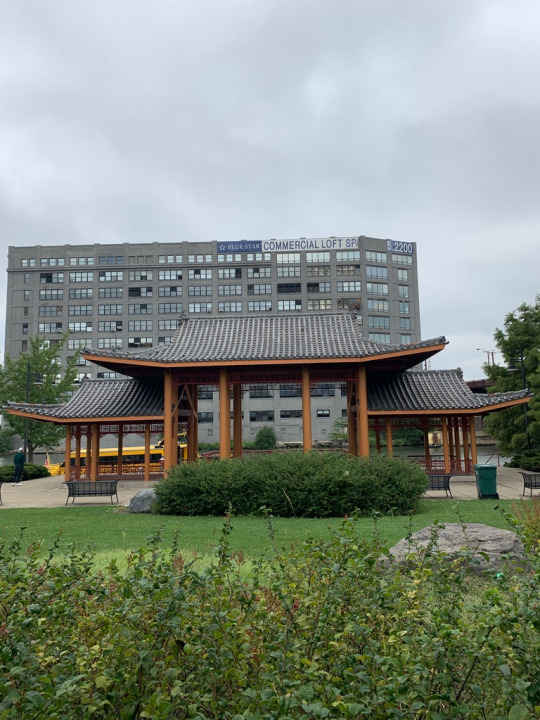
Ping Tom Memorial Park. The large plaza is the first thing that can be seen when first arriving. | Original photo

Memorial statue of Ping Tom, explaining the park’s significance to the community. | Original photo

A mural located under the bridge of Ping Tom Memorial Park. The cool blue tones of the mural add to the calming and reflective environment, and images of butterflies and flowers allude to the importance of nature and roots. | Original photo
To end our trip, my group and I decided to get lunch, leading to us venturing to Joy Yee Noodles, a popular restaurant known for their noodle cuisines and bubble tea. We decided to order two larger style dishes and share between the three of us. (Additionally, before you continue on to my food experience, I would say if you haven’t eaten here before, or it’s your first time dining in Chinatown, I solidly recommend Joy Yee! The staff was incredibly accommodating and their menus provided a wide range of fan favorites for first-time customers!)
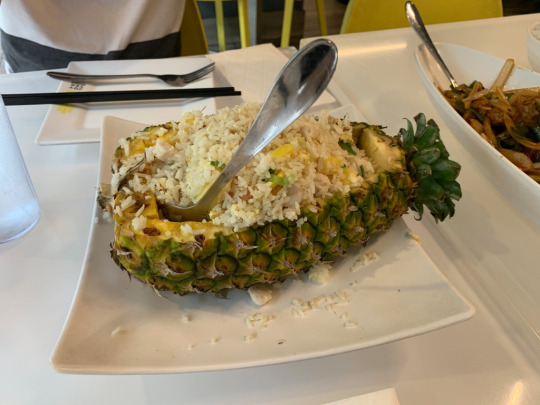
Special fried rice dish, ordered to share between our travel group. Delicious and plentiful. Couldn’t get over the creativity in the dish’s presentation. | Original photo
Even as a frequent Chinatown food-enthusiast, I have to say this rice definitely topped any rice dish I had tasted in the past. (Served out of a pineapple skin as well! Wow.) I had never had a dish like this, and I thought the “pineapple bowl” was an extremely unique conversation starter, and easy to share with friends as well.
Before heading out and venturing back home, I made it a goal of mine to order bubble tea as well. I ordered a lychee-strawberry smoothie with tapioca pearls, which was refreshing and new to me as well! Having only ever tried milk-based tapioca tea before, this fruit-based drink introduced my tastebuds to something I’m excited to try again in the future.
Boba rating: 5/5 starts | Cuisine rating: 6/5 stars (Extra credit for the pineapple bowl. Very innovative.)
Overall lunch break verdict: fair prices, decent portion size, and overall a very refreshing way to end my trip.

Ultimately, this trip to Chinatown was very eye-opening to the rich cultural history and experience the area has to offer outside of just its food restaurants. It excites me that Chicago’s Chinatown continues to grow, and has avoided the effects of gentrification because of the community’s morale and their general sense of belonging to the area (Eltagouri, 2016). Although this is my first documented trip in Chicago, I definitely had a moment during this trip where I realized how much I had been missing out on; the scenery, the architecture, the symbolism, the community, the lively people, the culture, all just one bus ride away from me. This trip excites me for the next to come and encourages me to get out of my comfort zone more often, to explore what the city has to offer.

City skyline view from Ping Tom Memorial Park. The park’s natural foliage contrasts the city skyline, a factor I thought contributed to the location’s beauty and overall balance between city view and nature. | Original photo
Sources:
(2018, October 9). THE BEST HERBS TO BUY IN CHINATOWN. Retrieved from http://chinatownreport.com/best-herbs-to-buy-in-chinatown/
District, C. P. (n.d.). TIP on Tour Finalist Party at Ping Tom. Retrieved from https://www.chicagoparkdistrict.com/parks-facilities/tom-ping-memorial-park
Ecker, D. (2019, May 10). The battle for Chinatown's future. Crain's Chicago Business.
Eltagouri, M. (2016, May 13). Here's why Chicago's Chinatown is booming, even as others across the U.S. fade. Chicago Tribune.
Our Building. (n.d.). Retrieved from https://www.puitak.org/about/building
The Meaning Behind the Nine-Dragon Wall in Beijing's Forbidden City. (2017, October 15). Retrieved from http://www.visiontimes.com/2017/06/23/the-meaning-behind-the-nine-dragon-wall-in-beijings-forbidden-city.html
Resources – Landmarks & Tourism. (2015, July 24). Retrieved from https://chicagochinatown.org/resources-landmarks-tourism/
0 notes
Text
From Chicagou to Chicago: Becoming the City it is Today
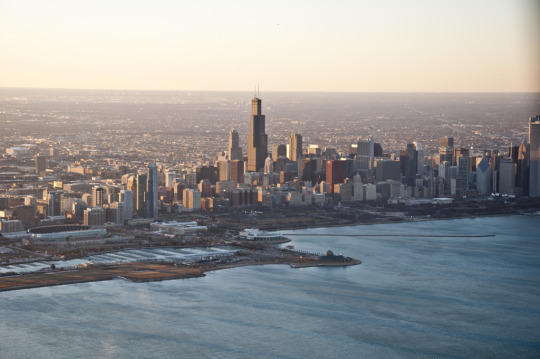
Aerial View of Chicago | Source
When thinking of the city of Chicago, what comes to mind may resemble the image above; a city characterized by skyscrapers, busy streets, and its vast skyline. Being the third-largest in the United States, Chicago is an ever-changing metropolis, fueled by innovation, art, commerce, and an abundance of cultural backgrounds. You might know the city by its buildings or its tourist attractions, but the historical roots of Chicago characterize the city known to be what it is today; what once were humble beginnings developed into what many walks of life consider a home.

Chicago terrain before its transition to a busy metropolis. During this time, Europeans and Native Americans both occupied the land and created trading communities with each other. | Source
Before it was Chicago, Native Americans recognized the land as Chicagou, or better known as “the wild garlic place” (Spinney, 9). In contrast to the environment, we know Chicago for today, this territory in the early 19th century was characterized by woods, prairies, streams of waters running through the land, and an abundance of Native Americans, animating the lively area. The Illinois Indians can be accredited to the Europeans’ discovery of land’s opportunities for portage, despite the Natives regarding the waters by their rancid onion-like smells. When French travelers Jacques Marquette and Louis Joilet passed through the Midwest area in 1673, Joliet recognized the Chicagou area offered the opportunity for colonial expansion and connections with the creation of a canal. Despite his counterpart’s differing opinions, this connection later came to be known as the Illinois-Michigan or I-M Canal, formed by connecting the Great Lakes and the Mississippi River. Whether the French explorers knew it or not, this canal served as the foundational start for Chicago’s booming transportation industry.

Prior to the construction of the Illinois Michigan Canal, Native Americans used areas like this to transport supplies via portage; carrying cargo or boats through the waterways. Additionally, this photo illustrates the environmental contrast to Chicago today, highlighted by corn/grain fields to the right and stretch of rural land. | Source
Just as Joliet felt about Chicago’s promising future, this mindset slowly spread to not only residents but outside states and different cultural groups of people. This boost of enthusiasm around the 1830s called folk in and out of the area to question what could make the city better. This is best observed through the influx of the city’s immigration rates as construction for the canal created a demand for labor workers. The Irish met this demand, migrating to Chicago to achieve building the 96-mile long canal, and finding settlement in the emerging city. Additionally, the canal created appeal for Yankees, causing New York folk to migrate with money for land settlement. These events in combination with the positive attitudes of city residents displayed the power that the canal and transportation had, and the potential for future connections Chicago offered because of its geographical location. The finish of the canal in 1848 ignited the spark for Chicago’s future transportation industry, paving way for the Chicago Railroad Industry.

Map of the Illinois-Michigan Canal. | Source

Elevated railroad train. | Source
Concurrently, the finish of the I-M Canal in 1848 was the same year the railroad’s first tracks were laid, beginning the foundation for Chicago’s Railroad industry. The invention of the railroad ultimately promoted settlement in the Midwest and revolutionized commerce, later serving as a catalyst for the development of the wheat/grain, meat, lumber, and mail order industries. In terms of commerce and trade, railroad travel perfected the method for shipping food and goods, in terms of delivery rates and quality. An example of this can be seen in the shipment of fruits or perishables; foods that tend to spoil if left for too long or damaged in toxic conditions were no longer tainted or harmed by water conditions. Moreover, in contrast to water-based canal travel, with railroad travel one didn’t have to worry about canal waters freezing, aiding farmers by opening trade to a year-round transport. This particular factor aided in the industrialization process, particularly for farmers, as crops and produce sold were a direct reflection of their fiscal progression; transitioning from season-specific to year-round transport boosts business for farmers and traders, but also the developing Chicago economy. Finally, this transition toward the railroad helped decrease the chances of diseases spreading previously rooted in unclean water conditions, best explained through the example of the spreading of Cholera in Chicago after coming to the city via canal water from New Orleans; with the implementation railroad travel, one could decrease the likelihood of catching this disease via portage. By 1856, Chicago was considered a “railroad hub”, offering wide success for transporting residents, prospective migrants, and products for trade/sales. While the canal was the preliminary stepping stone necessary for the assembly of Chicago’s industry, the railroad industry furthered that vision, bringing forth three additional new industries for the city (Chicago: City of the Century - From Mudhole to Metropolis, 2013).

Galena & Chicago Union Depot, 1848. | Source
From success in the development of the railroad came the growth and establishment for the wheat industry. The railroad industry was able to revolutionize commerce, and farmers were able to sell goods now faster and geographically further, as “the city was able to maximize its peculiar commercial relationships with New York City and the East” with a now larger market (Spinney, 49). With Chicago’s initial prairie-like terrain, farmers began building the wheat industry since corn & wheat were both plentiful, yet were substantial for meals and feeding livestock. Contrary to this, difficulties with these crops included their susceptibility to spoiling, seasonal availability, and the process involving a man-powered harvest. This problem met resolution in 1831 with the invention of the mechanical reaper; invented by American industrialist Cyrus McCormick, the mechanical reaper was a horse-drawn wheat harvesting machine made to aid the harvesting process and overall speed. Despite the reaper’s initial creation in Virginia, McCormick saw the greater opportunity the Midwest provided and decided to move to Chicago to eventually open his factory in 1847. In no time, Midwest farmers took great interest in McCormick’s innovation, and with the help of advertising and readily available transportation, the mechanical reaper had become commercialized with demand coming from areas in and outside of Chicago. While this commercialization of the reaper itself was a positive event, McCormick then encountered the issue of farmers lacking the income for purchasing. While knowing that the farmers’ income was highly dependent on grain sales, and grain was dependent on varying components such as seasons, weather, or production methods, McCormick implemented a pay later system, for when farmers had the crops, known today as credit. By establishing this system and the improvement of harvesting methods, grain had become a cash crop and the wheat industry had established itself in Chicago. Although later developed, both the establishment of the Chicago Board of Trade and the Futures Market aided this process of industrializing wheat, as the former regulated commercial sales and eliminated price uncertainty among farmers.
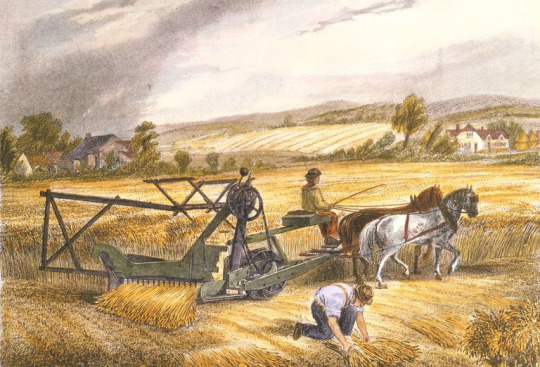
The Mechanical Reaper in action. | Source

Current-day, Chicago Board of Trade Building. | Source
With the wide success seen in the railroad industry and an increased need for amenities such as railroad tracks, houses, walkways, barrels for drinking water, log pipes, fuel, shipbuilding, and even windmills, this created an increased need for lumber, additionally becoming an industrialized commodity. Particularly concerning house construction, wood homes became increasingly popular. To make this process accessible, construction materials and instructions were transported via water travel for customers and future homeowners to construct, commercializing lumber even further as a modern-day IKEA (but on a larger scale with homes). Additionally, with the rise of the meat industry, the demand for lumber rose increasingly, as it was vital for creating fences for cattle and animals. All of these demands were met by the labor of men, as “there was never a shortage of men to harvest the trees” along with the forests in the area, as well as neighboring areas including Wisconsin, Michigan, and Minnesota (Spinney, 55). Ultimately, by the time of the Civil War, Chicago had become the largest lumber producer for the city’s time, adding on to Chicago’s industry success (Chicago: City of the Century - From Mudhole to Metropolis, 2013).

Stacks of lumber, highlighting the high demand in product | Source:
An additional industry affected by the development of the railway was the meat processing industry. Chicago particularly had what was described as a unique way of processing meat, and killing livestock. As the demand for meat rose with increasing migration rates and the success of the railroad, “butchering became a science”, and as meat was commercialized, the killing process became less perceived as inhumane, and more of doing it in the name of meeting the demand (Spinney, 57). This process was taken a step further with the creation of the disassembly line, by Philip Armour in the 1880s, a mechanical line that ran while workers would disassemble animals as much as they could without wasting meat; this process boosted Chicago’s meat processing industry, as meatpackers were able to profit off unwasted meat pieces while competing companies were scrapping them. Additionally, fellow meatpacker Gustavus F. Swift perfected transporting chilled meats with the invention of the refrigerated railroad car in the 1870s, responding and building to the demand even further, since now customers could purchase chilled meats rather than just salted meats. Regarding the systematic methods of meatpacking/processing, one may question if the process was ethical. In “The Jungle”, Upton Sinclair questions the philosophy behind the inhumane methods and rates of animal killings in exchange for meeting production demand, as the meat industry had entered full swing (Chicago: City of the Century - From Mudhole to Metropolis, 2013). Aside from questioning morale and ethics, one may debate whether the environmental effects of mass meat production were worth it, particularly the toxic air pollution produced, especially affecting homes or business neighboring meat factories, tending to result in disease.

Swift & Co.’s Packing House, 1906 | Source
Finally, the mail-order industry also grew and benefitted greatly from the success in transportation and the railroad industry. With the improvement of transportation and the ability for urban areas to now connect to countryside folk, farmers living in rural areas were now able to purchase Chicago products and contribute to the city’s economy. The first mail-order catalog was created by Aaron Montgomery, a Chicago resident, in 1872, sent directly to farmers’ homes, giving them the ability to shop the vast products offered (Spinney, 63). Montgomery’s goal with this was to form relationships with farmers, who often felt that they were “being exploited by predatory middlemen”, attempting to reduce their feelings of being overcharged and undervalued (Spinney, 63). Additionally, he introduced a guaranteed money-back system, a new concept to further build integrity with his customer demographic. The success of the mail-order industry can be examined through competing merchants to Montgomery Ward and Company’s mail-order, such as Richard Sears, who later surpassed Montgomery in sales and dominated the industry.

Montgomery Ward & Co Catalogue from 1895 | Source
Ultimately, as a city, Chicago’s nuance has been prominent since its early days of creation; people see and have always seen the city as one of opportunity and progression. A lot what we see in Chicago today; characteristics of ambition, drive, and excitement are all values that can be traced back to the city’s beginnings, and attributed toward the wide success seen from the four major industries. From a tiny portage swamp to a transportation hub, to a city marked by industry and commerce, the city of Chicago will always crave growth, and its history provides its community with a sense of pride and excitement for what’s to come out of this once wild garlic place.
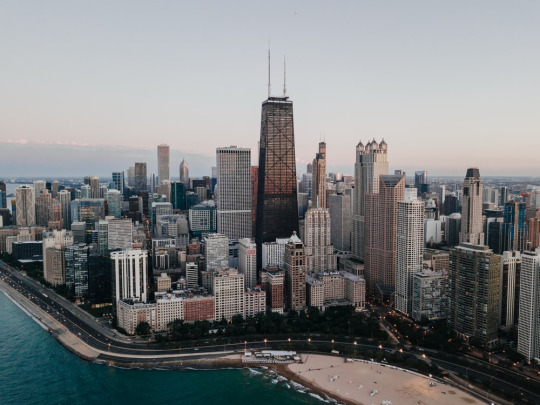
Chicago Skyline, Current-day | Source
Sources:
Chicago: City of the Century. (2003). Retrieved from https://www.pbs.org/wgbh/americanexperience/films/chicago/
Dukes, J. (n.d.). Without Native Americans, Would We Have Chicago As We Know It? Retrieved from https://interactive.wbez.org/curiouscity/chicago-native-americans/
Spinney, R. G. (2020). City of big shoulders: a history of Chicago. Ithaca, NY: Cornell University Press.
(n.d.). Digital Repository. Retrieved from https://www.humanitiestexas.org/archives/digital-repository/swift-cos-packing-house-chicago-illinois-1906
0 notes